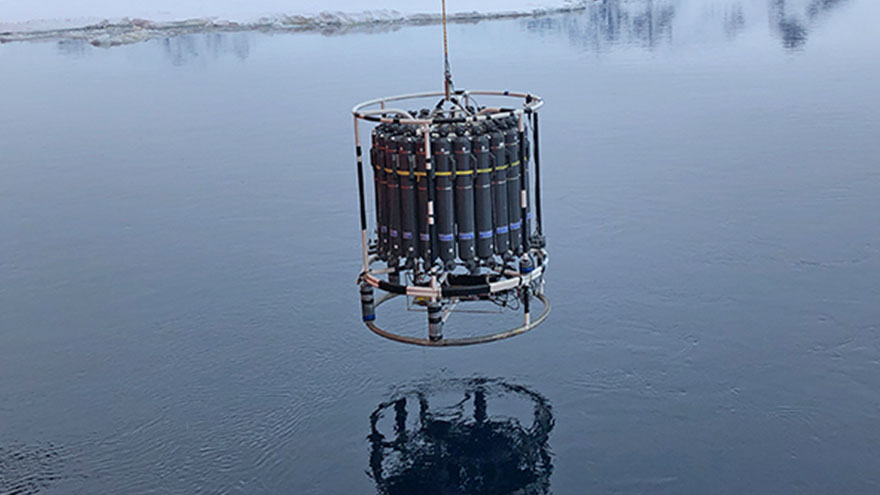Making Science Happen (whether it wants to or not…)
November 24, 2019 | Dr. Wade Jeffrey, Director of CEDB | wjeffrey@uwf.edu

So, what do we do onboard? As microbial ecologists, our sampling requires that we get water. The normal way to do this is with a CTD (Conductivity, Temperature, and Depth) rosette that also holds water sampling bottles. The system we have onboard holds twenty-four 12 liter bottles. It also contains sensors for chlorophyll fluorescence (tells is where the phytoplankton are), oxygen, transmittance (turbidity), and light intensity. Because the system is operated by computer from inside the ship, we can see real-time data as the instrument is lowered. Based on the patterns and profiles we see, we can then trip the bottles (collect water) at whatever depths we want when the CTD comes back up. Usually, we take water just below the surface and at what we call a “Deep Chlorophyll Maximum (DCM)” where phytoplankton abundance is highest. Here are photos of the CTD going into the water as well as the operation from the computer. Once the CTD comes back aboard, we then collect from the bottles for the various experiments we are doing. My grad student and I are mostly responsible for the measures of growth and production and community structure and diversity.
Those of you who followed along during our trip last April and May know that the CTD rosette never worked... So all of our samples were collected by throwing a bucket over the side to get water. This meant that we could get water from any depth we wanted... So long as it was the surface. Here is a photo of Leila learning the intricacies of bucket casting... We have conducted some preliminary comparisons to see if the bucket and CTD bottle give us the same results (spoiler alert: they don’t). We will continue to compare, but at least this time with a working CTD rosette we are really able to get water from any depth we want (so far the deepest has been about 1400 meters or over 4500 feet down).
When water comes aboard, the first thing is to scramble to collect the water from the bottles on the rosette. Time is always of the essence and we rush around so we can get our samples and assays going as quickly as well can. our standard measures include biomass (how many cells, and what kind - measured by both microscopy and flow cytometry), grazing rate experiments (how fast are the mixotrophs eating bacterial cells), microbial diversity (filtering water onto filters from which DNA will be extracted and sequenced when we return home), and bacterial and phytoplankton growth rates (using radio-tracer techniques- mostly what I do). Since several of our assays continue for 24 hrs, we intend to collect samples every other day – which gives us time to finish the assays, clean up, do initial data analyses, and get ready for the next sample. It keeps us busy... but of course we always throw in extra sampling and experiments as we get the opportunity too, which further complicates things. For instance, Leila and I are doing a series of experiments in support of her Masters Thesis. We will do this about 5 times during the entire trip. I have been also measuring bacterial growth rates in sea ice samples in collaboration with another project onboard – more about sea ice sampling in a future post.
Still looking for the ultimate penguin and seal photos…. I have seen relatively few penguins but we did see quite a few crabeater seals as we came into Marguerite Bay.
More soon about ice sampling and a visit to Rothera Station – the large British Research station in Marguerite Bay.








